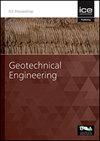Soil-structure interaction behind integral bridge abutments
IF 1.7
4区 工程技术
Q3 ENGINEERING, GEOLOGICAL
Proceedings of the Institution of Civil Engineers-Geotechnical Engineering
Pub Date : 2023-04-21
DOI:10.1680/jgeen.22.00115
引用次数: 0
Abstract
Integral bridges are preferred on infrastructure schemes as they have lower maintenance costs than a conventional jointed bridge. A key aspect of integral bridge design is the assessment of long-term passive resistance that develops in the abutment backfill due to seasonal movements of the superstructure. This resistance is currently defined by an intermediate earth pressure coefficient termed K*, and is typically evaluated using the Limit Equilibrium (LE) approach prescribed in BSI PD-6694-1:2011+A1:2020. This paper adopts the alternate numerical design approach and investigates the development of K* behind full height abutments using Soil-Structure Interaction (SSI) modelling in PLAXIS-2D. The study demonstrates that mobilised passive resistance is primarily a function of backfill and structural stiffnesses, and that the current LE approach does not capture the backfill resistance profile correctly. The effectiveness of the SSI method was verified by comparison to the LE method. The current study provides a SSI methodology that is an efficient design approach, and which is suitable for a wide variety of integral bridge arrangements beyond the current LE method applicability.整体桥台背后的土-结构相互作用
整体桥梁是基础设施方案的首选,因为它们比传统的节理桥梁具有更低的维护成本。整体桥梁设计的一个关键方面是评估由于上部结构的季节性运动而在桥台回填中产生的长期被动阻力。该阻力目前由称为K*的中间土压力系数定义,通常使用BSI PD-6694-1:2011+A1:2020规定的极限平衡(LE)方法进行评估。本文采用交替数值设计方法,利用PLAXIS-2D的土-结构相互作用(SSI)模型研究全高桥台后K*的发展。研究表明,动员被动阻力主要是回填体和结构刚度的函数,目前的LE方法不能正确捕获回填体阻力剖面。通过与LE方法的比较,验证了SSI方法的有效性。目前的研究提供了一种SSI方法,这是一种有效的设计方法,适用于各种整体桥梁布置,超出了当前LE方法的适用性。
本文章由计算机程序翻译,如有差异,请以英文原文为准。
求助全文
约1分钟内获得全文
求助全文
来源期刊
CiteScore
4.40
自引率
4.50%
发文量
68
审稿时长
3 months
期刊介绍:
Geotechnical Engineering provides a forum for the publication of high quality, topical and relevant technical papers covering all aspects of geotechnical research, design, construction and performance. The journal aims to be of interest to those civil, structural or geotechnical engineering practitioners wishing to develop a greater understanding of the influence of geotechnics on the built environment.

 求助内容:
求助内容: 应助结果提醒方式:
应助结果提醒方式:


